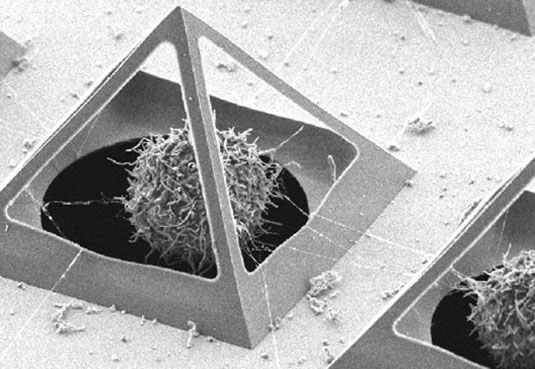The structure pictured below is a “microscopic pyramid,” New Scientist explains, “a cage for a living cell, constructed to better observe cells in their natural 3D environment, as opposed to the usual flat plane of a Petri dish.”
 [Image: A pyramidal “cell trapping device,” via New Scientist].
[Image: A pyramidal “cell trapping device,” via New Scientist].
It was constructed “by depositing nitrides over silicon pits. When most of the material is peeled away, a small amount of material remains in the corners to create a pyramid.”
This is called corner lithography, a technique used for creating the “cell trapping device” seen above.
The Giza-like, seemingly alien geometry of the pyramidal cage compared to the wild and barely containable spheroid burr of the cell itself is remarkable. The literally monstrous vitality of the cell caught inside the imposed order of the pyramid offers us an image of two fundamentally opposed methods of material organization in conflict with one another, a collision of orders as if the Gothic met the Doric or the Baroque met the Romanesque.
Interestingly, though, at least according to New Scientist, “Because the pyramids have holes in the sides and are close together, the cells can interact for the most part as they naturally do.” In other words, these apparently oppositional modes—the fuzzy and the straight—incredibly, even miraculously, don’t interfere with one another at all.
 [Image: Via New Scientist].
[Image: Via New Scientist].
Functionally speaking, it’s as if, from the cell’s perspective, the pyramid isn’t even there.
